Zigbee/IEEE 802.15.4 is a short-range wireless technology intended to provide applications with relaxed throughput and latency requirements in wireless personal area networks (PANs).It is designed to meet the needs for simple, low cost, low power and short range wireless networking. In this paper, we are analyse the performance of IEEE 802.15.4 topologies such as star, cluster tree, mesh of WPAN using different performance metrics like goodput ,throughput ,end-to-end delay with respect to routing protocol Ad hoc On demand Distance Vector(AODV)and Destination Sequenced Distance Vector(DSDV)usingNetworkSimulator2(NS2).Simulation results verify that DSDV gives better performance in star and cluster topologies and AODV gives better performance in mesh topology.
Keywords |
| WPAN, Star, Cluster Tree, Mesh, AODV, DSDV |
INTRODUCTION |
| Low rate wireless personal area network are designed to serve a variety of application with a focus on enabling
wireless sensor network[1].IEEE 802.15.4 is a short range wireless technology intended to provide application with
relaxed throughput and latency requirements in wireless personal area network (WPAN). The key features of IEEE
802.15.4 are low complexity, low power consumption, low data rate transmission and low cost [2]. Primarily it operates
in 2.4GHz ISM band and it makes the technology easily applicable and worldwide available [3]. The objective of our
work is to analyse the performance of IEEE 802.15.4 topologies based network by measuring goodput, throughput,
end-to-end delay, packet delivery ratio with respect to routing protocol AODV and DSDV using NS2. We have
analysed the performance by taking 8 nodes for star topology, 16 nodes for cluster tree topology, 25 nodes for mesh
topology in a wireless personal area network. |
| The organization of the paper is as follows: Section 1 gives brief introduction of WPAN and objectives of this
paper. Section 2 gives related work. Section 3 gives information about the proposed work of this paper. Section 4
describes performance metrics. Section 5 shows the result derived from the simulation carried out on different
topologies of IEEE 802.15.4 WPAN with respect to routing protocol using NS 2.35.finally Section 6 conclude the
paper and future work. |
RELATED WORK |
| Wireless Technologies playing its important role in medical appliances, because of low rate features. They
perform in a healthcare/hospital environment. Emerging low-rate Wireless Personal Area Network (WPAN)technology
as specified in the Institute of Electrical and Electronics Engineers (IEEE) 802.15.4 standard and evaluates its
suitability to the medical environment. Now the focus is on scalability issues and WPAN support to tens of
communicating devices in a patient's hospital room. The evaluation of packet effect segmentation and the backoff
parameter tuning to improve the overall performance of the network which is measured in terms of packet loss,
goodput, and access delay is done by N. Golmie [5]. |
| IEEE 802.15.4 protocols are gaining interests in both the industrial and research fields as candidate technologies
for Wireless Personal Area Networks(WPAN), control Wireless Networks applications and Wireless Sensor Network(WSN) [6] [7]. Here they analyzes multiple topologies such as Cluster-Tree, Mesh and Star with various
scenarios to compare the different performance metrics such as throughput, traffic sent, traffic received, delay etc. In
this analysis it was found that Cluster-Tree topology was best as compared to Mesh and Star topology because it take
20% and 45% load greater as compared to Mesh and Star Topology respectively. Similarly its throughput, delay, traffic
sent and traffic received were better than the other two topologies [4]. |
PROPOSED WORK |
| IEEE approved 802.15.4 standard defining the Medium Access Control sub layer (MAC) and the physical layer
(PHY) for low-rate, Wireless Personal Area Networks (LR-WPAN). It intends to offer the fundamental lower network
layers of a type of wireless personal area network (WPAN) which focuses on low-cost, low-speed ubiquitous
communication between devices. The devices typically operate in limited personal operating space. The following
figure1 shows the IEEE 802.15.4 architecture. |
| In above architecture, the physical layer supports three types of topologies: star, cluster tree and mesh
topology. In the star topology, communication is controlled by a PAN coordinator that operates as a network master,
end devices cannot communicate directly but they can communicate through PAN coordinator. Cluster-tree network is
just like a peer-to-peer network, each coordinator as a cluster head and multiple devices as leaf nodes. The network is
formed by parent-child relationships, where the new nodes associate as children with the existing coordinators. The
PAN coordinator may instruct a new child FFD to become the cluster head of a new cluster. Otherwise, the child
operates as a device. Mesh topology is decentralized network all devices can communicate directly with each other
within its range. It is a flexible and robust topology. |
| MAC layer is used for the data service, it provides a management interface and it manages to access physical
channel and network beaconing. It controls frame validation, guarantees time slots and handle node associations. Here
we are using network layer for packet forwarding and routing. There are two types of routing protocol: proactive and
reactive. AODV is a reactive routing protocol; it establishes a route to a destination only on demand to reduce traffic
overhead. DSDV is a proactive routing protocol; it maintains routing information of all the nodes in the network and
adds new routers or update existing routers by periodically distributing routing information among each other. The
major enhancement is the avoidance of loops. |
PERFORMANCE EVALUATION |
| We consider a IEEE 802.15.4 topologies of WPAN using operating frequency of 2.4GHz with maximum data rate
250kbps.For communication it used Omni directional antenna .A two-ray ground propagation model is used. The
queuing model used is drop tail queue. The routing is based on AODV and DSDV. Simulation parameters are given in
Table 1.In this paper, we consider following three performance metrics to compare IEEE 802.15.4 topologies with two
routing protocol. |
| 1. Throughput: It is the rate of successfully transmitted data packets in a unit time in the network during the
simulation. |
| 2. Goodput:It is a ratio between delivered amount of information, and the total delivery time. |
| 3. End-to-end delay: It is defined as the average time taken by the data packets to propagate from source to
destination. |
SIMULATION RESULTS |
| In this section, we consider the result obtained by the NS2.35 software simulation. Performance metrics are
calculated from ‘trace file’, with the help of AWK program. The simulation results are shown in the following section
in the form of bar graphs. Graph show the comparison between routing protocols with IEEE 802.15.4 topologies of
WPAN. |
| The figure2 and figure3 respectively shows the goodput and throughput of star topology with AODV and
DSDV routing protocol compared. The figure4 and figure5 respectively shows the goodput and throughput of cluster
tree topology with the values of AODV and DSDV routing protocol compared. Here goodput and throughput was
maximum amount of TCP packets are sent and receive from source to destination in terms of DSDV routing protocol,
because it is a proactive protocol and the advantage of these protocols is that a path to a destination is immediately
available, so no delay for route discovery is experienced when an application needs to send a packet and it maintains
periodic table which broadcast routing update to its neighbour. Here DSDV gives better performance than AODV. |
| The figure6 and figure7 show the end-to-end delay of star and cluster tree topology with AODV and DSDV
routing protocol compared. Here delay was minimum in AODV compare to DSDV routing protocol, because of high
node mobility in DSDV. |
| The figure8 and figure9 respectively shows the goodput and throughput of mesh topology with the values of
AODV and DSDV routing protocol compared. Here goodput and throughput was maximum amount of TCP packets
are sent and receive from source to destination in terms of AODV routing protocol, because of node density, less traffic
and free of channel. Here AODV gives better performance than DSDV. |
| The figure10 respectively shows the end-to-end delay of mesh topology with AODV and DSDV routing protocol
compared. Here delay was minimum in AODV compare to DSDV routing protocol, because of high node mobility in
DSDV. |
CONCLUSION AND FUTURE WORK |
| We have simulated and analyzed DSDV and AODV routing protocol with IEEE 802.15.4 topologies of WPAN
using different performance metrics. Finally we conclude that we got good performance in star and cluster tree
topology with DSDV routing protocol and mesh topology with AODV routing protocol. In future work, we may
examine other routing protocol such as OLSR, DSR etc with IEEE 802.15.4 topologies of WPAN using traffic metrics
to get efficient performance. |
Tables at a glance |
 |
| Table 1 |
|
Figures at a glance |
 |
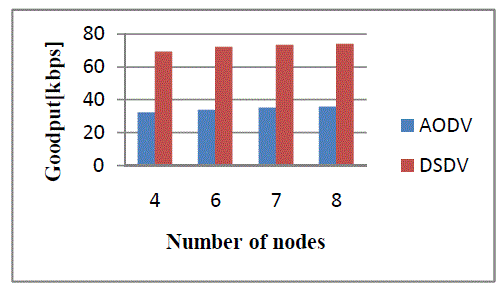 |
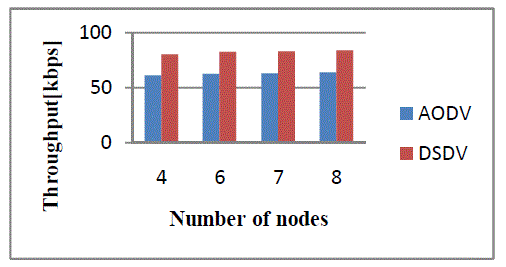 |
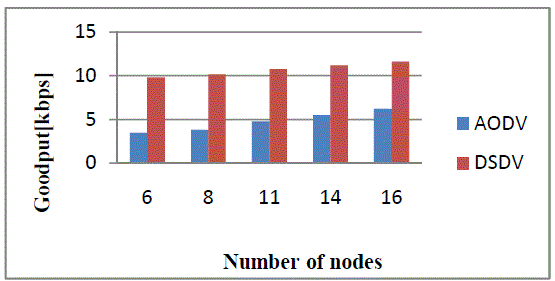 |
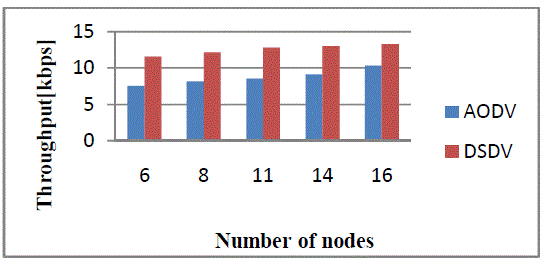 |
| Figure 1 |
Figure 2 |
Figure 3 |
Figure 4 |
Figure 5 |
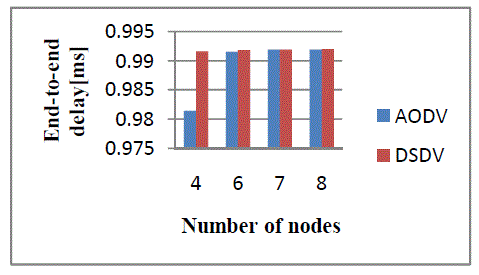 |
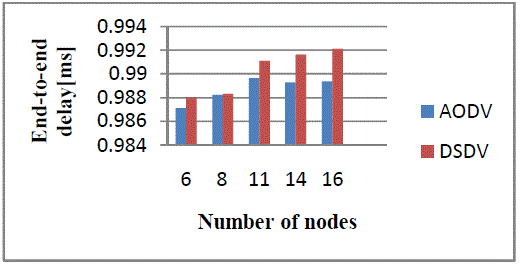 |
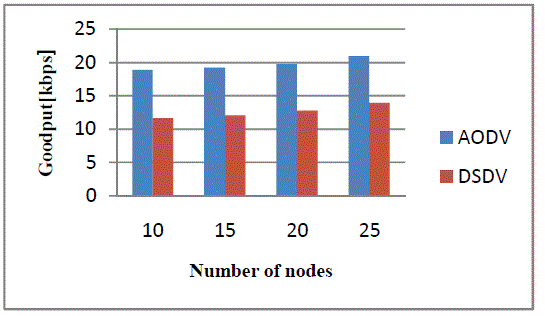 |
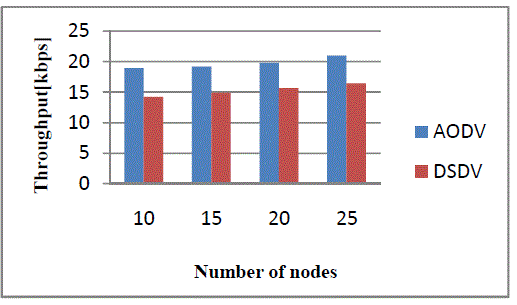 |
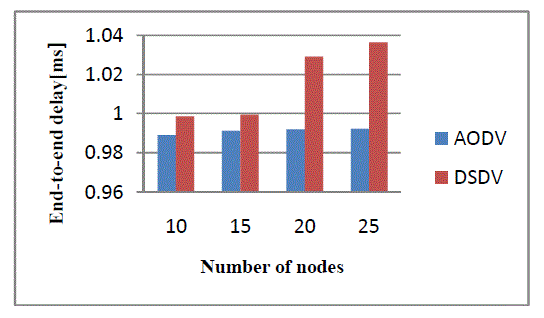 |
| Figure 6 |
Figure 7 |
Figure 8 |
Figure 9 |
Figure 10 |
|
References |
- Performance Evaluation Of An IEEE 802.15.4 Sensor Network With A Star Topology Chandramani Kishore Singh And Anurag Kumar.
- Performance Analysis Of IEEE 802.15.4 Beacon-Enabled Mode,ChiaraBuratti, Member, IEEE Transactions On Vehicular Technology, Vol. 59, No. 4, May 2010.
- Performance Analysis Of IEEE 802.15.4, Ms. Swati V. BirjeMr. Mahesh KumbharMr.Raviraj S. PatkarE&TC Dept., RIT Sakharale E&TC Dept., RIT Sakharale IT Dept., RMCET, AmbavShivaji University, INDIA Shivaji University INDIA Mumbai University INDIA,International Journal Of Advanced Research In Computer Science And Software EngineeringVolume 3, Issue 3, March 2013.
- Salman Naseer1 And S R Chaudhry, ?LR-WPAN Formation Topologies Using IEEE 802.15.4?IJCSI International Journal Of Computer Science Issues, Vol. 8, Issue 6, No 1, November 2011.
- Performance Analysis Of Low Rate Wireless Technologies For Medical Applications, N. Golmie, D. Cypher, O. Rebala.
- Andre Cunha; AnisKoubaa; Ricardo Severino, Mario Alves; ?Open-ZB: An Open Source Implementation Of The IEEE 802.15.4/ Zigbee Protocol Stack On Tiny OS? In 4th IEEE International Conference 2007.
- C. Evans-Pughe, ?Is The Zigbee Wireless Standard, Promoted By An Alliance Of 25 Firms, A Big Threat To Bluetooth?.? In IEEE Review, Vol. 49, Pp.28-31, March 2003.
- Comparative Performance Investigations Of Different Scenarios For 802.15.4 WPAN, Sukhvinder S. Bamber And Ajay K. Sharma, IJCSI International Journal Of Computer Science Issues, Vol. 7, Issue 2, No 4, March 2010.
- Performance Analysis Of AODV, DSDV and DSR in Manets Akshai Aggarwal1, Savita Gandhi2, Nirbhay Chaubey3, International Journal Of Distributed And Parallel Systems (Ijdps) Vol.2, No.6, November 2011.
- Destination-Sequenced Distance Vector(DSDV) Routing Protocol in ns-3,Hemanth Narra,YufeiCheng,EgemenK.Cetinkaya,JustinP.Rohrer And James P.G.Sterbenz.
- Analysis of ZigBee (IEEE 802.15.4 standard) for Star Topology with AODV Protocol, Priyanka Singh, Mukesh Kumar, A.K.Jaiswal,RohiniSaxena,International Journal of Innovative Technology and Exploring Engineering (IJITEE), Volume-3, Issue-1, June 2013.
- Performance Evaluation of DSDV and AODV Routing Protocols in Mobile Ad-hoc Networks, Md. MonzurMorshed Franz I. S. KoDongwook Lim,Md. HabiburRahman Md. RezaurRahmanMazumderJyotirmoyGhosh
|